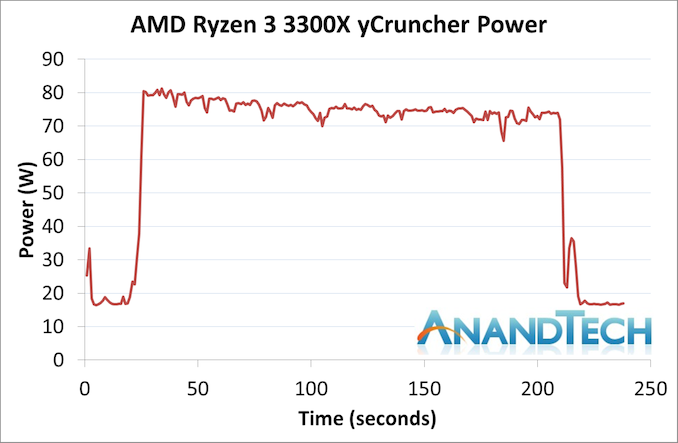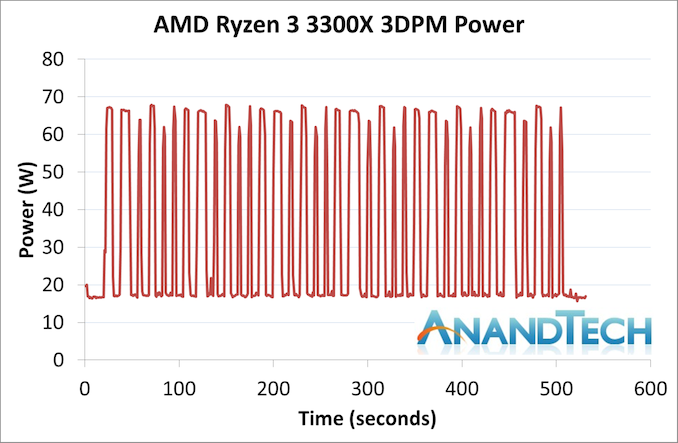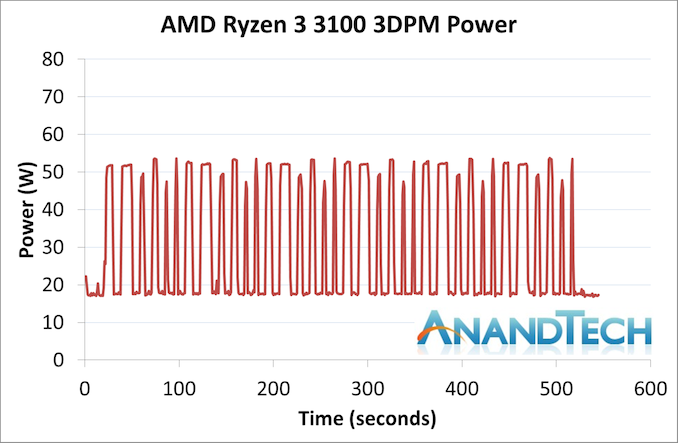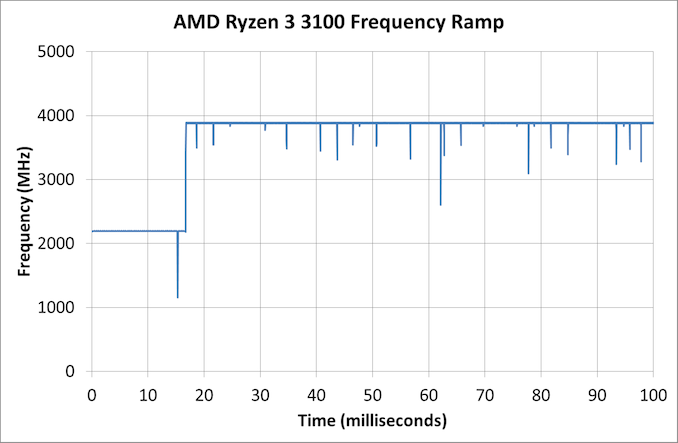The AMD Ryzen 3 3300X and 3100 CPU Review: A Budget Gaming Bonanza
by Dr. Ian Cutress on May 7, 2020 9:00 AM ESTPower Consumption and Frequency Ramps
On the box, both processors are listed as having 65 W TDPs. With its Zen-based hardware, AMD has been relatively good at staying around that official on-the-box value, even during turbo. In the last generation, AMD introduced a feature called PPT, or Package Power Tracking.
- For 105 W processors, PPT is >142 W
- For 65 W processors, PPT is >88 W
- For 45 W processors, PPT is >60W
This allows the processor to raise its power limits, assuming it isn’t breaching thermal limits or current limits, and consequently raise the frequency. As a result, while we see 65 W on the box, the real world power consumption during most tasks is likely to be nearer 88 W, unless the current or thermal lines are crossed.
As a new element to our testing, we are recording power over a number of benchmarks in our suite, rather than just a simple peak power test.
AMD Ryzen 3 3300X
For the faster chip, we saw a peak power in both of our tests of around 80 W.
With yCruncher, which is somewhat of a periodic load, the power consumption dropped over time to nearer 75 W.
3DPM is more obvious with its idle steps between loads, being 10 seconds on then 10 seconds waiting. The power almost peaked at a similar amount here.
In both of these graphs, the package power when idle is around 16-17 W. I looked back through the data, and noticed that out of this power only 0.3 W was actually dedicated to cores, with the rest being towards the big IO die, the memory controllers, and the Infinity Fabric. That’s still pretty substantial for an idle load.
At low loads, the power per core was around 14 W, while at full load it was slightly less depending on the test. This is a bit away from the 20 W per core we get from the high end Zen 2 processors, but these only go to 4.3 GHz, not 4.7 GHz+. This is about in line with what we expect.
On our frequency ramp test, the Ryzen 3300X went from an idle state to peak power within 17 milliseconds, or approximately a frame at 60 Hz.
One of the new features with Ryzen 3000 is CPPC2 support, which AMD claims to reduce idle-to-turbo ramping from 30 milliseconds to 2 milliseconds. We’re seeing something in the middle of that, despite having all the updates applied. That being said, the jump up to the peak frequency (we measured 4350 MHz, +50 MHz over the turbo on the box) is effectively immediate with zero skew across a range of frequencies.
AMD Ryzen 3 3100
Given that the TDP number on the side of the box says 65 W as well, any reasonable user would assume that the power of this chip would be equal, right? Regular readers will know that this isn’t always the case.
In our yCruncher test, because the turbo frequency is lower than the 3300X, it means the voltage can be lower, and thus power is lower. Our history of testing Zen 2 has shown that these cores get very efficient at lower frequencies, to the point where our processor doesn’t even break that 65 W threshold during yCruncher.
Similarly the 3DPM peaks are also lower, barely going to 55 W during an AVX2 workload.
On the frequency ramp side, we see another instance of a 16-17 ms transition.
Summary
For the peak power out of all of our testing, we saw the Ryzen 3 3300X hit a maximum of 80 W, and the Ryzen 3 3100 go to 62 W. When we compare that to the Core i7-7700K, at 91 W TDP / 95 W peak, combined with most of the results on the next few pages, AMD by comparison is more efficient.
















249 Comments
View All Comments
Spunjji - Monday, May 11, 2020 - link
You missed out on what Userbenchmark would add. Luckily most of us know the answer is "nothing".I'm now pretty convinced that you're a Deicidium sockpuppet.
Spunjji - Monday, May 11, 2020 - link
Oh for crying out loud. The first two posts in the comments wasted on a feckless simpleton blubbering that this site doesn't do the exact same things every other site does.Guess what laddoo - that's the point.
twizzlebizzle22 - Thursday, May 7, 2020 - link
Bit disappointed with the CPU selection used in this article.Thought it might be interesting to see how it fares against the 1600AF or R5 3600. Different CPUs which people might be considering if they're worth the extra.
amrnuke - Thursday, May 7, 2020 - link
Exactly. I'd have loved to see it up against the i3 9100F, 9400F. Comparison to the 3600 and 1600AF would be very welcome given the 1600AF's price range and 3300X vs 3600 would be very interesting from a gaming standpoint.DanNeely - Thursday, May 7, 2020 - link
None of those CPUs are in Bench, so Ian doesn't have any of them to test. The original 1600 is present for the older benchmarks, but not the newer ones. I wouldn't expect many CPUs to be run on the new ones until all of them are finished and ready to go in order to minimize the amount of time spent dis/reassembling test systems.flyingpants265 - Thursday, May 7, 2020 - link
Bench is terrible, it's missing way too many options. Most common problem I run into is when I'm trying to compare an older card (7870 or gtx660 or something) to a newer card, and they are just missing from the list. Just needs to be expanded and improved.0ldman79 - Thursday, May 7, 2020 - link
That's because the data sets don't overlap.They were run with different CPU, OS, etc...
I'd like for there to be a checkbox that says "these aren't scientific, you can compare incomplete, incorrect data at your own risk" etc, but there's a reason they aren't in the same listing; they're not the same.
Zizy - Friday, May 8, 2020 - link
The problem is that such data is often very misleading. By far the most important issue: there are many drivers touting >10% speedup in game X. You might as well guess which GPU is faster if they end up very close over many generations. Heck, simple "the new GPU has X% more CU and Y% higher frequency vs old one" is likely to lead to a better estimate than trying to correct for all that mess.regsEx - Thursday, May 7, 2020 - link
Worst part in the test is the RAM. That set of 3200C14 memory is very expensive - $160. That making entire build pointless. For that money you can get 32 GB kit with 6-core Core i3 10400.b0rnslippy - Thursday, May 7, 2020 - link
Oh Ian doesn't have them in Bench.. How convenient for Ian. Ehem, "Dr" Ian, sorry.